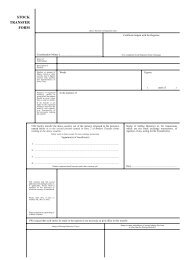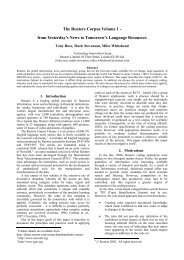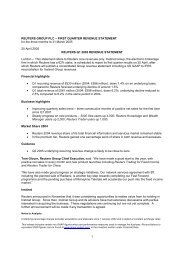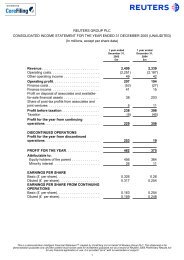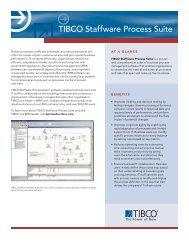TIBCO Staffware Process Suite
TIBCO Staffware Process Suite
TIBCO Staffware Process Suite
You also want an ePaper? Increase the reach of your titles
YUMPU automatically turns print PDFs into web optimized ePapers that Google loves.
enables comprehensive application integration capabilities through the <strong>TIBCO</strong><br />
BusinessWorks integration platform, or other third-party integration technologies.<br />
• Analysis - <strong>TIBCO</strong> <strong>Staffware</strong> <strong>Process</strong> <strong>Suite</strong> provides a sophisticated tool to<br />
analyze the effectiveness and efficiencies of entire business processes. It enables<br />
management to establish and continuously measure key performance indicators<br />
(KPIs) for ongoing process performance and improvement.<br />
<strong>TIBCO</strong> <strong>Staffware</strong> <strong>Process</strong> <strong>Suite</strong> and Dynamic <strong>Process</strong>ing<br />
<strong>TIBCO</strong>’s unique<br />
independent process<br />
layer separates the<br />
business process logic<br />
from the application<br />
layer, making integration<br />
much smoother and<br />
infinitely scalable.<br />
For most business processes, in addition to the recognized steps or activities that make up<br />
the process, there are a number of recognized exceptions that may occur along the way.<br />
At the same time, business processes contain a certain dynamic element that is driven by<br />
the inherent fluid nature of most processes. For example, in a loan application process, a<br />
recognized exception is that the applicant fails the credit check. The point in the process<br />
at which these types of exceptions may occur can be anticipated and can be built into the<br />
automated business process. At the time that exception is recognized, additional process<br />
steps may need to be added.<br />
On the other hand there are other types of exceptions that could occur at any point<br />
within the process. Examples of these types of exceptions are: a person gets married and<br />
changes name, a person dies, or notification is received that a loan application is being<br />
investigated for fraud. In some processes the number of identified exceptions may be<br />
numerous. Any attempt to build handling for such exceptions and dynamic processes<br />
into the process would result in a very large spaghetti-like process that would be almost<br />
impossible to enhance or maintain.<br />
The handling of these types of exceptions and dynamic processes may also vary. Some<br />
may need separate processes to be initiated, some may need the main process to be<br />
suspended while other activities take place, some may require process data to be modified<br />
to take into account changed circumstances, and others may indicate that the current state<br />
of the process needs to be changed.<br />
<strong>TIBCO</strong> <strong>Staffware</strong> <strong>Process</strong> <strong>Suite</strong> provides functionality to support these kinds of dynamic<br />
processes. In cases where continuing to work on the business process after an exception<br />
has occurred may invalidate the end result of the process, <strong>TIBCO</strong> <strong>Staffware</strong> <strong>Process</strong> <strong>Suite</strong><br />
allows the process to be suspended while the exception is being handled. Once the<br />
exception has been handled through external processing, then the original process can be<br />
reactivated or closed as appropriate.<br />
T I B C O S ta f f w a r e P r o c e s s S u i t e



